
Georgetown City Heritage Tour
Umana Yana
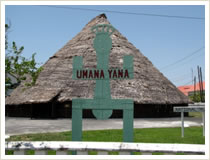 The Umana Yana is a conical palm thatched hut (benab) erected for the Non-Aligned Foreign Ministers Conference in Guyana in August 1972 as a V.I.P. Lounge and recreation centre. Situated on High Street next to the Pegasus Hotel Guyana, it is now a permanent and much admired part of Georgetown's scenery, and is in constant use as an exhibition and conference centre. The structure is 55 feet (16.78 meters) high and is made from thatched allibanna and manicole palm leaves, and wallaba posts lashed together with mukru, turu and nibbi vines. No nails were used. It was erected by a team of about sixty Wai-Wai Amerindians one of the nine indigenous tribes of Guyana. Fashioned like the Wai-Wai benabs or shelters which are found deep in Guyana's interior, it occupies an area of 460 square metres, making it the largest structure of its kind in Guyana.
The Umana Yana is a conical palm thatched hut (benab) erected for the Non-Aligned Foreign Ministers Conference in Guyana in August 1972 as a V.I.P. Lounge and recreation centre. Situated on High Street next to the Pegasus Hotel Guyana, it is now a permanent and much admired part of Georgetown's scenery, and is in constant use as an exhibition and conference centre. The structure is 55 feet (16.78 meters) high and is made from thatched allibanna and manicole palm leaves, and wallaba posts lashed together with mukru, turu and nibbi vines. No nails were used. It was erected by a team of about sixty Wai-Wai Amerindians one of the nine indigenous tribes of Guyana. Fashioned like the Wai-Wai benabs or shelters which are found deep in Guyana's interior, it occupies an area of 460 square metres, making it the largest structure of its kind in Guyana.
The African Liberation Monument
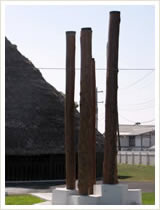 On 26 August 1974, the unveiling of this beautiful structure was done by former President Linden Forbes Sampson Burnham outside the benab “in memory of all of those who have struggled and continue to struggle for freedom from Human Bondage”. The monument consists of five polished Greenheart logs encased in a jasper stand on a granite boulder which represents the strength of the freedom movement. The pebbles around it signify the millions of people involved in the Freedom fight.
On 26 August 1974, the unveiling of this beautiful structure was done by former President Linden Forbes Sampson Burnham outside the benab “in memory of all of those who have struggled and continue to struggle for freedom from Human Bondage”. The monument consists of five polished Greenheart logs encased in a jasper stand on a granite boulder which represents the strength of the freedom movement. The pebbles around it signify the millions of people involved in the Freedom fight.
Walter Roth Museum
 The Walter Roth Museum is a museum of anthropology in Georgetown, Guyana and claims to be the oldest such museum in the English-speaking Caribbean region. It was established in 1974, but not opened to the public until 1982. The museum is a non-profit institution created by the Government of Guyana to collect, exhibit and conserve artifacts relating to the ancient cultures of Guyana, to conduct anthropological research and disseminate knowledge of the Indigenous Peoples of Guyana through its in-house and out-reach programmes.
The Walter Roth Museum is a museum of anthropology in Georgetown, Guyana and claims to be the oldest such museum in the English-speaking Caribbean region. It was established in 1974, but not opened to the public until 1982. The museum is a non-profit institution created by the Government of Guyana to collect, exhibit and conserve artifacts relating to the ancient cultures of Guyana, to conduct anthropological research and disseminate knowledge of the Indigenous Peoples of Guyana through its in-house and out-reach programmes.
St. George’s Cathedral
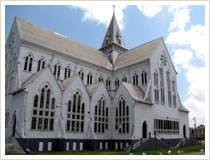 St. George’s Anglican Cathedral in Georgetown, Guyana is the second tallest wooden building in the world with its tower rising to 143 ft. St. George’s Cathedral which is Gothic in style was designed by Sir Arthur Bloomfield and opened on 24th August, 1892. The building was dedicated on 8th November, 1894. It is located on Church Street in Georgetown and has been designated a National Monument.The story of the Cathedral is told in the interior on tablets and memorials. It is part of the history of Guyana in general and the diocese in particular.
St. George’s Anglican Cathedral in Georgetown, Guyana is the second tallest wooden building in the world with its tower rising to 143 ft. St. George’s Cathedral which is Gothic in style was designed by Sir Arthur Bloomfield and opened on 24th August, 1892. The building was dedicated on 8th November, 1894. It is located on Church Street in Georgetown and has been designated a National Monument.The story of the Cathedral is told in the interior on tablets and memorials. It is part of the history of Guyana in general and the diocese in particular.
City Hall
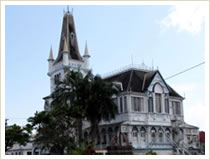 The Georgetown City Hall, located in Georgetown, Guyana was completed in 1889. Its architecture is described as Danube Gothic in timber, largely due to its stylized tower, with wrought – iron crenellations at the very apex. The building is open to the public, and the once- handsome concert hall, on the third floor, is a curious sight to behold. It is now the temporary home of the Departments of Environment and Health.
The Georgetown City Hall, located in Georgetown, Guyana was completed in 1889. Its architecture is described as Danube Gothic in timber, largely due to its stylized tower, with wrought – iron crenellations at the very apex. The building is open to the public, and the once- handsome concert hall, on the third floor, is a curious sight to behold. It is now the temporary home of the Departments of Environment and Health.
Supreme Court of Judicature (High Court)
 This impressive L shaped structure which houses the seat of the nation’s judiciary was designed by Baron Hora Siccama, the colonial civil engineer and Caesar Castellani, then an assistant architect with the Public Works Department. The building reflects two distinctive architectural designs. The ground floor is constructed of masonry and circular columns and has the appearance of classical architecture of early Rome and Greece. The timber frame walls of the upper floor are a reminder of the wooden buildings erected in England during the Tudor period. Noteworthy features include the high pitched roof and ornate metal cresting all serving as eloquent reminders of Georgetown’s renowned timber architecture.
This impressive L shaped structure which houses the seat of the nation’s judiciary was designed by Baron Hora Siccama, the colonial civil engineer and Caesar Castellani, then an assistant architect with the Public Works Department. The building reflects two distinctive architectural designs. The ground floor is constructed of masonry and circular columns and has the appearance of classical architecture of early Rome and Greece. The timber frame walls of the upper floor are a reminder of the wooden buildings erected in England during the Tudor period. Noteworthy features include the high pitched roof and ornate metal cresting all serving as eloquent reminders of Georgetown’s renowned timber architecture.
Parliament Building of Guyana
 Guyana’s Parliament building, designed by Joseph Hadfield, was built on a foundation of greenheart logs. The foundation stone was laid in 1829 and, in April 1834, the structure, stuccoed to resemble stone blocks, was completed. Having been completed, the building was formally handed over to a committee of the Court of Policy on 5th August, 1834.
Guyana’s Parliament building, designed by Joseph Hadfield, was built on a foundation of greenheart logs. The foundation stone was laid in 1829 and, in April 1834, the structure, stuccoed to resemble stone blocks, was completed. Having been completed, the building was formally handed over to a committee of the Court of Policy on 5th August, 1834.
Stabroek Market
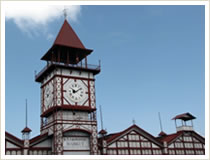 The Stabroek Market is a large market located in the capital of Guyana, Georgetown.
The Stabroek Market is a large market located in the capital of Guyana, Georgetown.
In 1842, the Georgetown Town Council designated the current location of the market on Water St., officially recognizing it as a market despite the fact that it had served such a capacity for quite some time. The market was designed and constructed by the Edgemoor Iron Company of Delaware, USA over the period 1880-1881. Construction of the iron and steel structure was completed in 1881 and may be the oldest structure still in use in the city. Designed by an American engineer Nathaniel McKay, this market houses a wide variety of items for sale. The market covers an area of about 80,000 square feet (7,000 m2).Though the architectural style is elusive, the iron structure and the prominent clock tower is reminiscent of the Victorian era of Great Britain.
Botanical Gardens
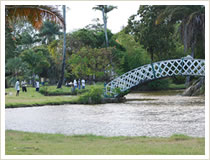 The Botanical Gardens is one of Georgetown's popular recreation parks. In 1877, Government devoted $72,000 to establish the Gardens, and John Frederick Waby, the first gardener, arrived in Georgetown in December 1878. He spent 35 years in Guyana landscaping one of the finest tropical gardens in our region. These gardens have a huge variety of tropical flowers and one of the finest collections of palms, as well as lovely lilies. An example of the gardens vast collection is the lotus and the immense Victoria Regia Lily, Guyana's national flower, which was first discovered in the Berbice River. This park exhibits a variety of the flora and fauna of Guyana. The first attempt to establish a Zoo dates back to 1880, but the members of the Royal Agricultural Society were opposed to the idea. However in 1952, the Zoological Park was declared open.
The Botanical Gardens is one of Georgetown's popular recreation parks. In 1877, Government devoted $72,000 to establish the Gardens, and John Frederick Waby, the first gardener, arrived in Georgetown in December 1878. He spent 35 years in Guyana landscaping one of the finest tropical gardens in our region. These gardens have a huge variety of tropical flowers and one of the finest collections of palms, as well as lovely lilies. An example of the gardens vast collection is the lotus and the immense Victoria Regia Lily, Guyana's national flower, which was first discovered in the Berbice River. This park exhibits a variety of the flora and fauna of Guyana. The first attempt to establish a Zoo dates back to 1880, but the members of the Royal Agricultural Society were opposed to the idea. However in 1952, the Zoological Park was declared open.
The Seawalls
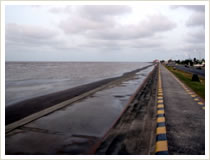 The most famous stretch of seawall in Guyana is the Georgetown Seawall. Seawall is the name given to the wall of concrete built along the foreshore, mostly in Demerara. It is part of the battle against the sea since Guyana is below sea level. Earth walls are called sea-dams. The Georgetown Seawall is a favourite place for afternoon walks, listening to music (at the bandstand), for races on the beach, for spontaneous cricket matches, for lovers’ trysts and other activities. In 1903 the Georgetown Seawall Bandstand was built with funds subscribed by the public as a memorial to Queen Victoria.
The most famous stretch of seawall in Guyana is the Georgetown Seawall. Seawall is the name given to the wall of concrete built along the foreshore, mostly in Demerara. It is part of the battle against the sea since Guyana is below sea level. Earth walls are called sea-dams. The Georgetown Seawall is a favourite place for afternoon walks, listening to music (at the bandstand), for races on the beach, for spontaneous cricket matches, for lovers’ trysts and other activities. In 1903 the Georgetown Seawall Bandstand was built with funds subscribed by the public as a memorial to Queen Victoria.
Please contact us for more details.
